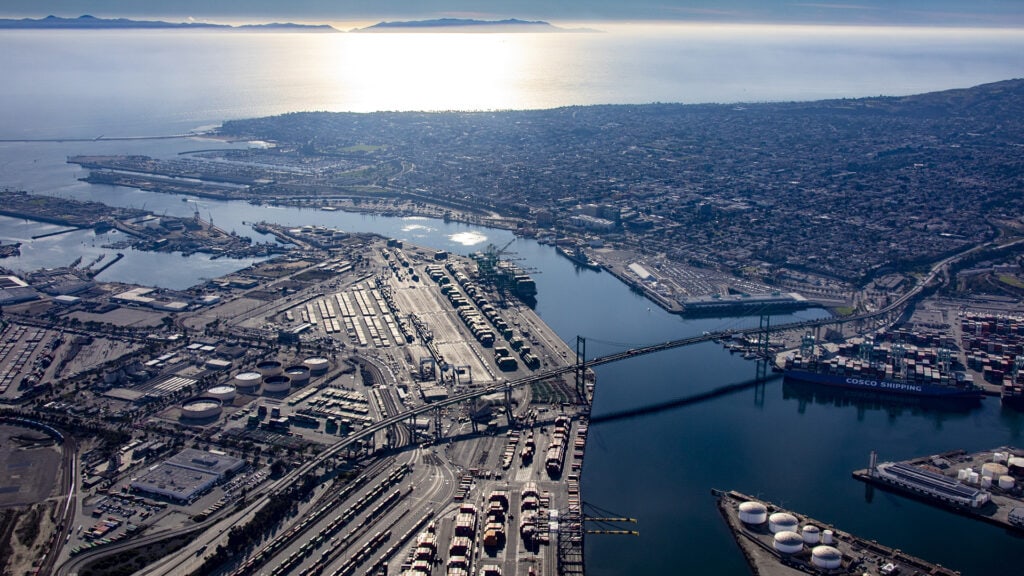U.S. Ports: Pivot and Improve
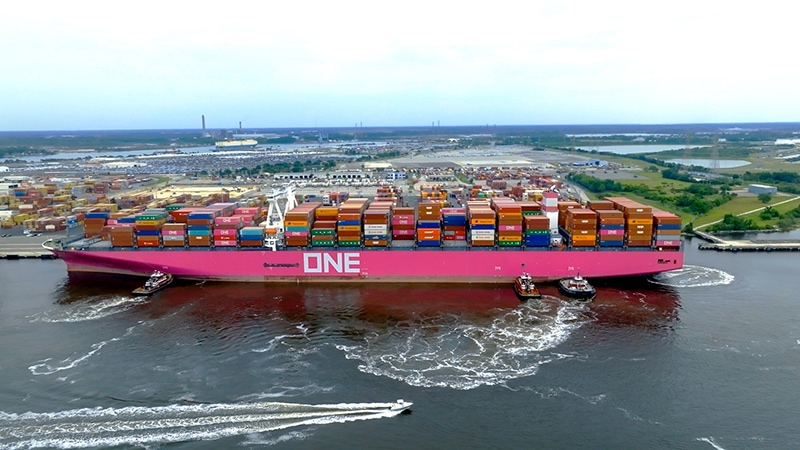
U.S. ports have weathered storms that forced slow steaming of supply chains across the globe. Through it all, the ports stand as studies of American resilience and innovation, serving as powerful lighthouses to the world.
Lockdowns. Border closings. Geopolitical tensions. Shifting trade routes. Over-supplies. Under-supplies. While the pandemic may have constituted its initial wave, the tsunami of supply chain issues afflicting logistics over the past few years did not cease, even after the economic waters returned to relative calm.
Despite all challenges, however, U.S. ports from sea to shining sea have continued to pivot and improve. Together, the ports are emblematic of international logistics leadership in the post-pandemic era.
“America’s ports play a central role in our supply chains,” said U.S. Transportation Secretary Pete Buttigieg early in 2023 as he announced $662 million in available FY2023 funding for the Port Infrastructure Development Program (PIDP) under the auspices of the Maritime Administration.
The PIDP program supports efforts by ports and other industry stakeholders to improve port and related freight infrastructure to meet the country’s freight transportation needs and ensure that port infrastructure can handle an anticipated growth in freight volumes.
In 2022, the Department of Transportation awarded more than $703 million to fund 41 port projects in 22 states and one territory.
“So many of the goods we all count on—from appliances to furniture to clothes—move through our nation’s ports on their way to us,” Buttigieg said.
Well before the availability of the 2023 funding was announced, U.S. ports began initiating an impressive array of infrastructure and other improvements designed to answer demand, unclog supply chains, and facilitate the free flow of goods for shippers.
A few examples of new and continuing projects include forward-thinking efforts ranging from massive expansions in capacity to new big-ship callings to data-sharing agreements enhancing supply chain performance among and across regional ports.
Let’s check in on some of these efforts, with a little port-hopping.
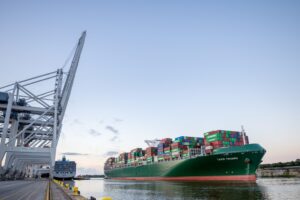
The Georgia Ports Authority plans to renovate the docks at Ocean Terminal in Savannah to provide two additional big ship berths, and transform the 200-acre facility to a container-only operation by 2026.
Georgia Ports Authority: Growing Bigger Together
The enthusiasm and pride of port officials at the Georgia Ports Authority (GPA) is evident in GPA Executive Director Griff Lynch’s remarks as he tours the new Savannah Transload Facility, a 300,000-square-foot warehouse one mile from the Garden City Terminal, just weeks prior to its scheduled opening in July 2023.
NFI Industries, a third-party logistics partner offering transportation, distribution, global logistics, and real estate solutions, will operate the facility.
The project is a case study in collaboration. “If we’re going to grow big successfully, the entire supply chain needs to be ramped up together,” Lynch says, adding that NFI will handle more than 400 containers each day and as many as 150,000 containers each year through the new facility alone.
“But it doesn’t stop there,” Lynch notes. “The Savannah area is adding more than 21 million square feet of building to date, and there’s another 30 million square feet on the drawing board. We’re going to have more than 150 million square feet in the next two years, just in the local market.”
The Savannah investment means that capacity challenges are finally being put in the rear-view mirror, thus increasing speed to market, Lynch says. Cargo moving through the Savannah Transload Facility will start its inland trek to stores and distribution centers faster, saving time—and money—for GPA shippers and partners.
In additional port enhancements, GPA is renovating Berth 1 at its Garden City Terminal. When those improvements are finished, the port will be able to simultaneously serve seven vessels, including four 16,000-TEU ships. The improved berth will add 1.5 million 20-foot equivalent container ships of annual berth capacity.
The GPA also is transitioning its 200-acre Ocean Terminal in Savannah. Having handled a mix of containers and breakbulk cargo for 40 years, Ocean Terminal will become an all-container facility.
Rebuilding the docks will provide 2,800 feet of berth space, capable of simultaneously serving two big ships. The first berth is set to be completed in 2025 and the second in 2026.
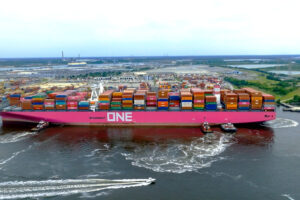
JAXPORT recently set a new port record with the arrival of the vessel ONE STORK, the largest container ship to ever call Jacksonville. Operated by shipping line Ocean Network Express within THE Alliance network of ocean carriers, the ONE STORK has a carrying capacity of 14,000 TEUs. ONE STORK is the first of nine larger vessels that will call JAXPORT weekly through the EC5 container service operated by THE Alliance.
JAXPORT: Europe Calling
Down the Atlantic coast in Florida, there is no less enthusiasm as the first ship in MSC Mediterranean Shipping Company’s ScanBaltic to USA service began calling JAXPORT—the Port of Jacksonville—with the arrival of MSC England in April 2023.
SSA Atlantic provided stevedoring services at the SSA Jacksonville Container Terminal at JAXPORT’s Blount Island Marine Terminal.
The bi-weekly, direct European container service calls seven destinations in Northern Europe, including locations in Lithuania, Poland, Sweden, Germany, England, Belgium, and France.
“We are excited about this service addition that provides shippers and customers more routes to move their cargo to key markets,” says Robert Peek, JAXPORT’s chief commercial officer.
ScanBaltic to USA is MSC’s fifth container service at JAXPORT. The international shipping line also offers service from JAXPORT to destinations in Asia through the 2M Alliance as well as a North America service, Canada and Gulf Bridge, and two Caribbean services, Bahamas Express and Florida Gulf Feeder.
Record-Setting Call
Shortly after the arrival of MSC England, JAXPORT set a record with the arrival of the vessel ONE STORK, the largest container ship ever to call the port, utilizing Jacksonville Container Terminal’s newly deepened 47-foot harbor at Blount Island. The harbor provides the water draft needed to accommodate the larger vessels. ONE STORK, which made its first arrival in May 2023, has a carrying capacity of 14,000 TEUs.
ONE STORK is the first of nine larger vessels that will call JAXPORT weekly through the EC5 container service operated by THE Alliance, which has upsized the vessels in the service. It replaced smaller ships with six larger 14,000-TEU and three larger 13,000-TEU vessels.
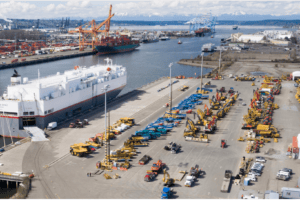
The Northwest Seaport Alliance, the marine cargo partnership between the ports of Seattle and Tacoma, recently launched its 2023 Rail Cargo Incentive Program aimed at driving growth and cost-effective operations in the Pacific Northwest region.
Northwest Seaport Alliance: Pacific Progress
The Northwest Seaport Alliance (NWSA), comprising the seaports of Seattle and Tacoma in Washington state, launched its 2023 Rail Cargo Incentive Program in April 2023.
The program provides a $50 per rail lift incentive for eligible rail volumes moving through the gateway. It is expected to generate some 60,000 additional rail lifts. That’s equivalent to 15% of NWSA international intermodal lifts in 2022.
“The NWSA strives to be the most efficient gateway for cargo movement, and the implementation of the rail incentive will ensure that we remain cost-competitive while offering the same best-in-class service for our customers,” says Deanna Keller, NWSA co-chair.
“As competition in the shipping industry intensifies with current market conditions, the rail cargo incentive program is an important tool to help attract additional cargo volumes that provide critical jobs for maritime workers across our gateway,” adds Sam Cho, NWSA co-chair.
The NWSA supports the establishment and growth of inland rail hubs to drive agriculture export cargo to the Tacoma and Seattle seaports. Most intermodal inland ramp locations served and/or operated by the BNSF and Union Pacific railroads will be eligible for the incentive program including ramp locations in Minot, North Dakota; Pocatello, Idaho; Millersburg, Oregon; and Wallula, Washington.
Data Partnership
In spring 2023, five California seaports—the Port of Los Angeles along with the ports of Long Beach, Oakland, Hueneme, and San Diego—signed a memorandum of understanding to launch the California Port Data Partnership alongside state and federal partners.
The memorandum outlines an agreement among the five ports to jointly advance computerized and cloud-based data interoperability (Interoperability is the ability of computer systems or software to exchange and jointly make use of information). The ports share a common goal: to support improved freight system resilience, goods movement efficiency, emissions reduction, and economic competitiveness.
The agreement “will create a greener, more transparent and more efficient supply chain, unlocking innovation in how cargo moves in California,” says California Lt. Gov. Eleni Kounalakis.
The partnership will serve as the basis of cooperation for $27 million in grant funds from the California Governor’s Office of Business and Economic Development for port data system development and emerging data aggregation and analysis efforts that support freight and supply chain resiliency.
“Sharing vital shipping data will reduce delays and aid the entire goods movement industry from the docks to doorsteps,” says Mario Cordero, executive director of Port of Long Beach. “By working together, California’s ports can enable end-to-end visibility and connectivity across the supply chain.”
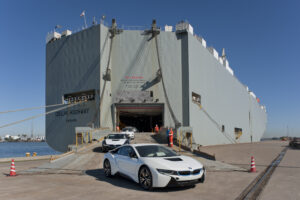
BMW Group operates a Vehicle Distribution Center at the Port of Galveston to handle and process imports.
Texas Pride
A similar example of cooperation exists in Texas, where a strong and collaborative port system is vital to maintaining the state’s position as the nation’s top exporter and importer by tonnage.
The state’s 20 public ports handle more than 616 million tons of foreign and domestic cargo and represent 25% of the state’s GDP, according to the Texas Ports Association.
“While our Texas ports may compete with each other for business, we also work together through the Port Authority Advisory Committee (PACC) to raise awareness with key decision-makers about the vital roles Texas ports play and our future needs,” says Rodger Rees, port director and CEO, Galveston Wharves at the Port of Galveston.
“To meet demand and remain competitive with ports across the United States, Texas ports are investing heavily in upgrading their facilities,” Rees notes.
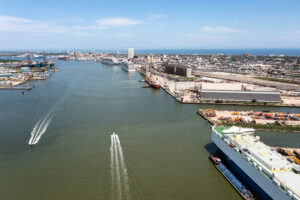
The Port of Galveston consists of the Galveston Ship Channel, the south side of Pelican Island, the north side of Galveston Island, and the entrance to Galveston Bay.
The Port of Galveston is implementing a 20-year Strategic Master Plan that details more than $600 million in major capital and maintenance improvements to maximize port assets. Port capital projects include an internal roadway, a fourth cruise terminal, and expansion and improvements to the West Port Cargo Complex.
These efforts, like those at ports large and small across the country, are in keeping with the shared mission of U.S. port officials to help improve supply chain reliability through increased port capacity and resilience.
As Buttigieg says, the goal of port investment is to strengthen U.S. supply chains and position the nation for economic success.
West Coast Ports Promote Sustainability
The Port of Los Angeles, the busiest container port in the Western Hemisphere, and the Port of Long Beach have taken yet another step in their national and international leadership of sustainability efforts. The ports’ latest initiative is to collaborate on environmental issues with the Port of Tokyo and the Port of Yokohama.
Agreements to that end were signed by California port officials during the 2023 California Japan Clean Energy Trade Mission in March.
“California and Japan’s port partnership is a world-leading collaboration and a critical step toward achieving zero greenhouse gas emissions,” says California Lt. Gov. Eleni Kounalakis.
The ports of Tokyo and Yokohama also agreed to establish a green shipping corridor partnership with the Los Angeles and Long Beach ports in the coming year, an initiative aimed at reducing emissions along their respective trade routes and promoting low- and zero-carbon ships and fuels.
The Los Angeles and Long Beach ports already have established green shipping corridor partnerships with the ports of Shanghai and Singapore, announced in 2022 and April 2023, respectively. All these efforts have the support of C40 Cities, a global network of mayors working collaboratively to address climate issues.
“Curbing greenhouse gases from international shipping is essential to fight global warming,” says Mario Cordero, executive director, Port of Long Beach.
“Creating this green corridor with our partner ports and C40 Cities is part of our strategy to coalesce all of our efforts here and beyond to help advance our goals for cleaner marine fuels for oceangoing vessels, improve efficiencies for the global movement of goods, and to achieve a carbon-neutral future,” he adds.
Given that the flow of air and water cannot be contained within impenetrable boundaries, the agreements speak to the need for collaboration in ports’ environmental efforts.
“No single port or organization can tackle the challenge of decarbonizing the supply chain alone, no matter how innovative their technology or robust their efforts,” said Gene Seorka, executive director, Port of Los Angeles, in remarks accompanying the LA-Singapore agreement.
“The establishment of this green shipping corridor between the San Pedro Bay Port Complex and Singapore will prove to be a living, breathing testament to the power of global collaboration,” he added.
The Los Angeles and Long Beach ports comprise the San Pedro Bay Port Complex, which handles more containers per ship call than any other port complex in the world.
The California ports’ latest agreements add to a legacy of collaboration among U.S. and foreign ports. The long history of cooperation between the Port of Los Angeles and Port of Yokohama dates to a trade agreement signed in 1969 to strengthen trade routes between the two ports. Additionally, the Port of Los Angeles and Port of Tokyo formalized a Sister Port relationship in 1987.

